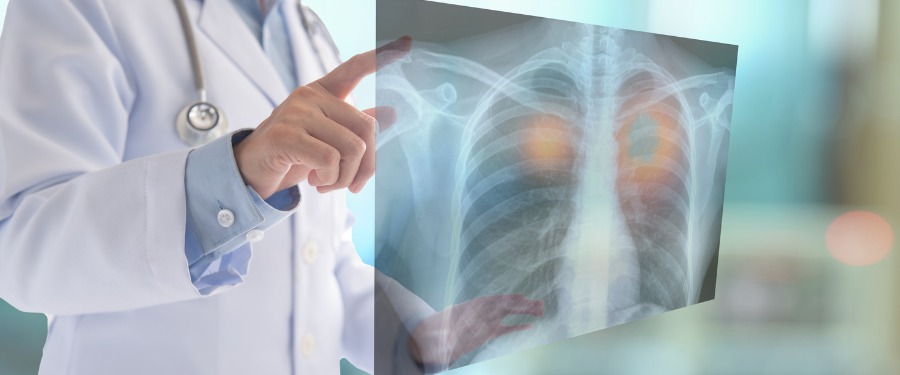Small cell vs. non-small cell lung cancer: An overview

Lung cancer, the leading cause of cancer deaths in the United States, occurs when cells within the lung begin growing in an uncontrolled way, forming tumors or lesions. It typically begins in the cells lining the bronchi, and can eventually spread throughout the lung and to other parts of the body.
The broader term of lung cancer is made up of two primary types: non-small cell lung cancer (NSCLC) and small cell lung cancer (SCLC). While they were initially named this way due to the appearance of the cells under the microscope, these groupings have remained because symptoms, treatments, and prognoses are similar for each.
Below, we will provide an overview of the differences between small cell and non-small cell lung cancer, including how they are distinguished and the similarities they share.
An overview of non-small cell lung cancer
What is non-small cell lung cancer?
Non-small cell lung cancers make up 85% of lung cancer diagnoses, and the most prevalent risk factor for NSCLC types is smoking. There are three common types of non-small cell lung cancer: adenocarcinomas, squamous cell carcinomas, and large cell carcinomas. Smoking is estimated to cause around 90% of cases, but asbestos exposure, radon, air pollution, COPD, and other lifestyle factors can also contribute to a person’s risk.
Additionally, recent research has shown that genetic mutations can also play a role in a person’s likelihood of developing lung cancer. It is not impossible for a person who has never smoked to be diagnosed, and recent research has found that nonsmokers who get lung cancer often have genetic mutations of EGFR, ALK, or ROS1 genes.
Non-small cell lung cancer stages
If lung cancer is detected, medical professionals will perform tests to determine what stage the non-small cell lung cancer has advanced to. The stages are as follows:
- Stage 0: Abnormal cell groups have appeared in the top layers of lung tissue but have not yet spread
- Stage I: The tumor is small and fully contained within the lung
- Stage II: The cancer has not yet spread, but the tumor is larger
- Stage III: The tumor is large and may have spread into surrounding tissues and lymph nodes
- Stage IV: Cells from the tumor have detached and traveled to other parts of the body
Non-small cell lung cancer symptoms
The symptoms of non-small cell lung cancer are common to all lung cancers and can include a persistent cough, chest pain, trouble breathing, fatigue, wheezing, and hoarseness.
How is non-small cell lung cancer treated?
The recommended treatments for non-small cell lung cancer depend heavily on an individual’s age, overall health, and whether the cancer has begun to spread. Sometimes, it is possible to perform surgery and remove the affected tissue. Other treatments can include radiation, chemotherapy, and immunotherapy. Additionally, non-small cell lung cancer clinical trials can be an option for patients who are interested in trying potential new treatments.
An overview of small cell lung cancer
What is small cell lung cancer?
Small cell lung cancers make up 10 to 15% of lung cancers, and SCLCs tend to grow and spread more quickly than NSCLCs. The two types of small cell lung cancers are small cell carcinoma and combined small cell carcinoma, both named for the kinds of cells found in the cancer. Smoking is the most prevalent risk factor for SCLC, but radiation exposure, a family history of lung cancer, and pollution can all have an impact.
Small cell lung cancer stages
Staging for small cell lung cancer works the same as staging for NSCLC. Stage 0 is when abnormal cells are first detected, Stage I denotes a small tumor that has not spread, and so on.
Small cell lung cancer symptoms
Just as with non-small cell lung cancer, small cell lung cancer symptoms can include a persistent cough, chest pain, trouble breathing, fatigue, wheezing, and hoarseness.
How is small cell lung cancer treated?
Treatment of small cell lung cancer is similar to treatment of NSCLC, and can include surgery, radiation, chemotherapy, and immunotherapy. Though SCLC grows and spreads more quickly than NSCLC, it also tends to respond better to chemotherapy and radiation treatments, but does tend to have a high rate of recurrence.
For all types of lung cancer, clinical trials are vital to the discovery of new treatments and therapies that can help patients both today and tomorrow — but participants must take part for research to advance. To learn more about clinical trials that are enrolling now, use the button below to get started.
Topics: For Patients
